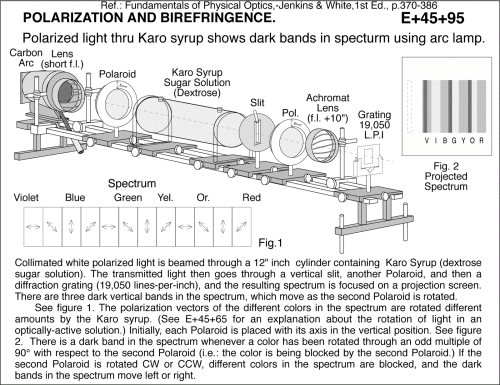Polarized light thru Karo syrup shows dark bands, using arc lamp.
Primary tabs
Polarized light thru Karo syrup shows dark bands in specturm using arc lamp. Ref.: Fundamentals of Physical Optics,-Jenkins & White,1st Ed., p.370-386 Collimated white polarized light is beamed through a 12" inch cylinder containing Karo Syrup (dextrose sugar solution). The transmitted light then goes through a vertical slit, another Polaroid, and then a diffraction grating (19,050 lines-per-inch), and the resulting spectrum is focused on a projection screen. There are three dark vertical bands in the spectrum, which move as the second Polaroid is rotated. See figure 1. The polarization vectors of the different colors in the spectrum are rotated different amounts by the Karo syrup. (See X for an explanation about the rotation of light in an optically-active solution.) Initially, each Polaroid is placed with its axis in the vertical position. See figure 2. There is a dark band in the spectrum whenever a color has been rotated through an odd multiple of 90 deg with respect to the second Polaroid (i.e.: the color is being blocked by the second Polaroid.) If the second Polaroid is rotated CW or CCW, different colors in the spectrum are blocked, and the dark bands in the spectrum move left or right.
UCB Index:
E+45+95
UCB Taxonomy:
Popularity:
- Log in to post comments

